I decided a few months ago it was time for me to get into the world of plant grafting. I posted a few weeks ago about some pre-grafted fruit trees I bought, as well as some root stock. I expected this all to start in the course of the coming months, but then I had the idea of doing a citrus graft!
This all started when I read Christina’s post here, about some mandarins in the garden of a friend. She mentioned a variety named Shirokolistvennyi, a Russian variety believed to be very cold hardy. That started me thinking, if there was a cold hardy mandarin that grows in Russia, why couldn’t I grow it here in Amsterdam?
I asked Christina if her friend might be able to send me a cutting to make a graft with, only to find out she lives in an area under citrus quarantine, and scion wood is not even allowed to be transported locally. This is to prevent the spread of disease.
After some looking, I found some scion budwood was available from the USDA GRIN germplasm collection. I agreed with the curator he would send me some — if I would first send him a copy of the ‘letter of authorization’ he said was required for European import of citrus. So I set off on the great paper chase.
I called customs, the plant disease control people, the people who perform inspections on plant imports (this has all been privatized, outsourced and just a real mess in general).
Everyone I talked to said the same thing. There are no restrictions on importing citrus budwood into the Netherlands (I don’t know about the rest of the EU), so there was no ‘letter of authorization’ to issue, in fact no one I spoke to had ever heard of a letter of authorization.
The USDA GRIN curator said he couldn’t issue a phytosanitary certificate or any other paperwork, until I could give him the letter of authorization.
Finally we agreed he would just skip all the paperwork, and send it!
So there it is, in the middle, in the plastic bag.
While waiting for GRIN to process my budwood request, I set out to find rootstock for grafting. Those are the two plants, Poncirus trifoliata, also called Trifolate orange, a citrus relative, said to be very cold hardy and good for use as grafting rootstock. They are really thorny!
I found the plants at a local nursery De Groene Prins. It turns out the guy that runs the nursery has been looking for cold hardy citrus to grow locally for some time now, so we had a walk through his garden and he showed me some of the plants he’s experimenting with! He was very knowledgeable and helpful, and certainly worth a visit for anyone looking for exotic cold hardy plants in the Netherlands.
Above is a grafting knife I bought a few months ago on a visit to San Diego California. They sell it there in part because it’s used by the citrus industry. It’s made by Victorinox, and in fact pretty widely available.
I had two plants, so I decided I would make two different kinds of grafts. First a standard graft, then a bud graft.
For the standard graft, I cut a piece of the budwood and the top of the plant at roughly the same angle. The budwood is on the left here. I also cut a further notch in it, that was too small to really show up in the picture, but it is right below the tips of each of these cuts in the down direction. The intention is to make a bit of a notch, so the two pieces will interlock a bit.
Here they are slotted into one another. The budwood is on top. This stayed in place long enough by itself to take this picture.
Next I put some grafting wax on it. I read different places on the Internet that you should either put the wax on first or tape if first, not knowing for sure which I should do, I started with the wax.
Actually while looking at the pictures I took to make this post I see maybe if I used tape first, I could have taped the graft closed a bit. None of the surfing around on the subject I’ve done had suggested this might be a good idea.
The wax was purchased locally and called grafting wax, but I’m not really sure it’s the right product. I needed to melt it over a flame first, and it wasn’t very easy to apply. None of the wax really penetrated the graft at all, it’s just sort of stuck to the outside.
In the absence of an actual product called grafting tape, I used masking tape. I had read somewhere that it was okay to do this, but I’m not sure…
Above is the bud graft I made. The process of doing this was far less picturesque. In fact it was very difficult, and I hope not too much blood is showing in this picture. Cutting a bud off the scion wood was no problem, together with some surrounding plant tissue.
You are supposed to slot this into a T-shaped cut on the stem of the root stock. This is really a lot harder to make than it might seem. It’s very woody, and when you make a cut with a knife that’s so sharp, the cut disappears right away. When you try to cut it again with the knife, you make a second parallel cut, that just damages the plant and isn’t very good for slotting the bud into.
Anyway, next time I will approach it more like using the knife to sort of gouge the cut up from below.
The graft is held in place with a rubber band, as an alternative to grafting rubber.
This was sort of a difficult first grafting attempt to make, but then again I guess I’m never for doing anything the easy way.
Actually, in the process of ordering the budwood and buying the rootstock, a Russian friend of mine searched the Internet in Russian for this variety of mandarin. It turns out it’s more commonly known by the name Gruzinskiy Shirokolistnyi, which means Georgian Wide Leaved Mandarin. There isn’t any specific information available in Russian about it being cold hardy, but it is supposed to be good for low light conditions (at the possible expense of fewer fruits). This is promising for me, because low light in the winter can be a problem. Georgia however has a much warmer climate than me, so I’m a little worried it really is cold hardy.
What my Russian friend said she read, in general, mandarins are hardy down to -5C with no damage, and at -10C may be killed. It’s pretty unusual the temperature gets down to -10C here, but it does happen. This winter it got to about -12C.
At the same time, the rootstock I’m using is supposed to make the tree more cold hardy, so this may help. I understand the rootstock is good down to -20C by itself.
Anyway, I guess I first have to worry about the graft working, then worry about the cold hardiness.
The last part of this story is that I had extra budwood left over after making these two grafts. I traded them with the guy who runs the nursery where I got the Trifolate orange for these above! Three seeds from his Yuzu lemon tree, also known to be very cold hardy. He had two of these plants, one outdoors and one in his polytunnel. The outdoor plant didn’t have any fruits yet, perhaps still too young, but it survived this past very cold winter with flying colors. His indoor plant had some fruit on it, and it looked and smelled like a very nice quality lemon.
If anyone out there who has ever done grafting before has any comments, I’d love to hear them. Especially if this doesn’t work, I’d love to know why…



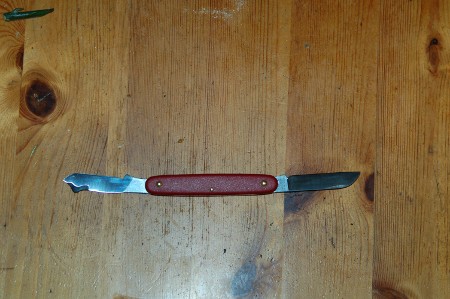
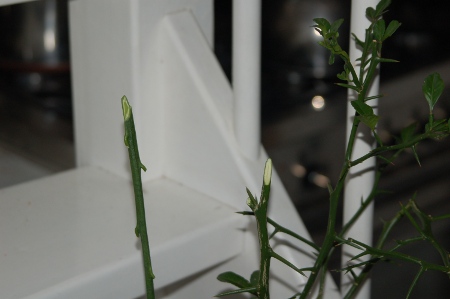
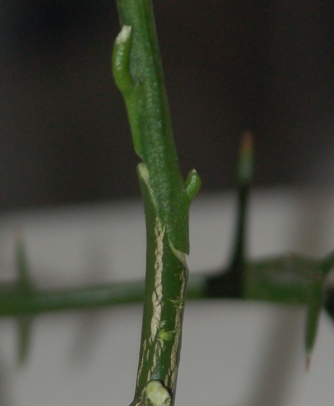
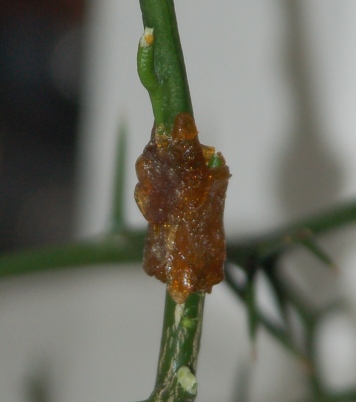


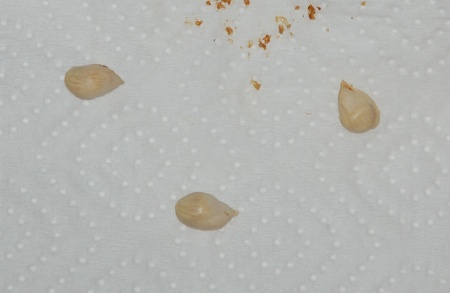
In nor cal, they protect garden citrus on the coldest nights by covering them with sheets, which seems to work. Good luck!
Don’t let those lemon seeds dry out – they’re recalcitrant and will be killed by desiccation. Often citrus are polyembryonic, giving rise to what are effectively clones of the parent plant – a useful characteristic. Good luck with your grafts. I have several scars where the knife slipped on occasion.
Strictly speaking, they’re “non-orthodox”, but in any case they’ll do better kept chilled and moist until planted.
As I see it, the tape is to fix the graft, keeping the graft right at the spot, so the wound heals quickly.
The wax is used to reduce evaporation from the wound, so it doesn’t dry out. The wax would prevent healing if it penetrated the graft!
When I’ve done bud grafting, I’ve done it in July, when the growth peaks, at the bark for that reason is more loose. Then it’s more easy to slit the T-cut open and slide down the bud. Also the bark shouldn’t be too old when bud grafting.
Thanks everyone!
I think I’ll just get those lemon seeds started right away…
Do you have access to parafilm? It’s a wax tape that stretches and seals against itself. It’s what I’ve been taught to use to seal grafts, and with the few grafts I have made this year, it’s been easy to use.
I can’t wait to see how these grow for you!
Hi Christina, I’m quite certain parafilm isn’t available here, but it sounds like just what I need.
Besides masking tape, I’ve also heard the suggestion of using plastic freezer bags cut into strips or Scotch tape (called cello tape in the UK, I think? It’s probably called other things in other places, but it’s the plastic tape you use to tape two pieces of paper together).
I’ve never seen anything for sale around here called grafting tape.
Parafilm is available in Denmark – guess it must also be possible to find it somewhere in the Netherlands?
Yes, Parafilm (or similar product) will be available in any microbiology lab. I would have thought that most tapes even masking tape would suffice – I’m sure I used it once. The aim is to keep the graft union tight and to exclude water and dirt. How about Band Aid? If the knife slips, you’re already prepared.
I don’t have access to any microbiology lab, nor do I see it anywhere for sale online. I’ll keep an eye out for it…
Patrick,
I’ve ordered the parafilm online, http://www.charlesmusic.com, search for parafilm…
Don’t let the graft dry out. (cover the whole plant with a transparant plastic bag)
Good luck!!!
Thanks Erik! I guess I’m the only one here who’s never heard of parafilm before…
Hey Patrick –
That’s nothing to be ashamed of….. But seriously, if you’ve got any friends in a university or horticultural college (especially if they do anything involving Petri dishes), they’re bound to have access to it. If you haven’t got any friends in such institutions, get some, they’re VERY useful. It comes in a wide roll and you cut strips off it to wrap round and seal the Petri dishes. The standard lab size ( I forget the dimensions) will give you enough tape to do hundreds of grafts, maybe more. Good luck.
Normally citrus is t-budded when the seedling root stock is bout pencil size to 3/8th inch in diameter. this done when the bark is slipping. Can be done in the spring after new growth has started or in the fall while the bark is still slipping. Tbudding is much easier tand fater than grafting
Hi Bonnie,
Thanks for the feedback! I think I should have planned the timing of this a little better.
That and I guess next time I’ll need a supply of parafilm on hand…